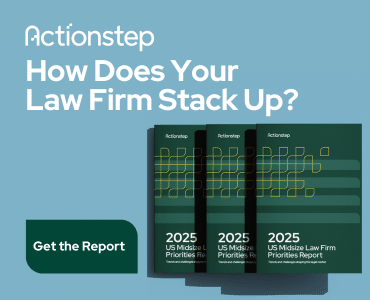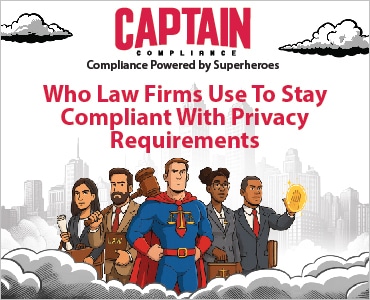GenAI shortcuts are tempting, but generic AI content can alienate your audience. Here are three strategies for creating human-centered legal content for your website and blog.

Table of contents
Balancing Efficiency and Authenticity in Your Content Strategy
In 2025, legal content marketing stands at a crossroads between efficiency and authenticity. While generative artificial intelligence (GenAI) offers tempting shortcuts, compelling and well-performing legal content still requires a distinctly human element. Unfortunately, this is where AI falls short. This doesn’t mean it isn’t useful for helping create content for your law firm’s blog, but it does mean you can alienate readers by posting articles that are more ChatGPT than human.
According to data aggregated by Finances Online, 97% of attorneys have zero personal content on their websites, and few law firms leverage data analytics to create content that directly addresses their clients’ needs or preferences. This means that leaning on AI-heavy blog content is exacerbating a problem that already existed in the legal industry before ChatGPT arrived.
To be clear, I’m not saying that you shouldn’t use GenAI in your content creation process. I’m saying that it’s just another tool in the toolbox, and for content to rank, you need to make it stand out in the vast sea of generic AI content that is growing deeper every day.
Here are three human-centered strategies to balance AI efficiency with your authentic legal voice.
1. Infuse Your Content with True Thought Leadership
Thought leadership is the real deal — you can’t cut corners with it. Whether expressing a new concept or unique insight, thought leadership connects the dots in a fresh way. Like the name implies, there is some risk required in advocating a new perspective. On the other hand, this is precisely why thought leadership content is compelling and cuts through the clutter.
The Content Marketing Institute says creating content that stands out is a top priority across industries. In other words, the struggle to produce truly innovative blog posts is felt universally. In that frustration, AI may seem like a mirage in the content desert. However, if you ask Chat GPT if it’s good at thought leadership, the answer is, “AI can support thought leadership, but it isn’t naturally a thought leader on its own.”
AI excels at data analysis, brainstorming, synthesizing concepts, summarizing details, and automation. Again, according to Chat GPT, AI is not good at:
- Generating groundbreaking ideas and coming up with unique insights
- Communicating any real emotional nuance or complexity
- Taking risks, which often relies on some type of “gut feeling”
- Relationship-building and credibility, which, as Chat GPT pointed out, are foundational requirements for thought leadership to take hold
Additionally, Chat GPT told me it’s not good at thought leadership because it has no personal convictions and lived experience. As far too many of us know, going through a divorce or a car accident is far different than merely analyzing one.
The right way to use AI in thought leadership pieces for your law firm’s blog is to think of it as an experienced legal assistant. Only you can practice law and give legal advice, but your assistant does the grunt work. For example, in this section, I asked AI to expand on my idea, not to generate the idea.
2. Don’t Be Shy about Expressing Strong Opinions
Taking a step back to see the big picture, there are plenty of lawyers for potential clients to choose from out there. As a consumer in the market for legal representation, who do you hire when they all seem so qualified and experienced?
This is where something as simple as a photo of you with your family, rather than a picture of you in a suit next to law books, can make a difference. Now you are memorable. The same logic is true for the content on your website. The middle ground is safe, but it’s boring. If you want to create life-changing legal content that never dies, it’s not going to happen in the comfort zone. Unfortunately, AI-generated content is the epitome of the comfort zone.
Expressing “strong opinions” doesn’t have to be brash or in-your-face. It just has to be passionately stated and fiercely defended. Here are some ways to get started asserting strong opinions on your law firm’s blog:
- Take a stand on upcoming legislation. Why does your law firm support or not support the proposed law? How would this law’s passing impact your clients?
- Discuss a recent court decision. Demonstrate your legal prowess by exploring new case law. It’s also an opportunity to show you can explain complex legal concepts to average people. (This is also known as “newsjacking” — offering your take on current legal news.)
- Propose a new law: Show why this legislation is needed and the holes in the existing law. You can even offer a copy-and-paste letter to your local government official that readers can email.
How can AI help with these types of opinion pieces? It can identify unpopular laws, what’s on the ballot that may affect your clients, help you brainstorm your subheadings, and assist with filling in paragraphs and bullet points.
3. Use Original Research to Stand Out From the Crowd
Some car accident attorneys have already started commissioning traffic surveys. Not only can this be helpful as evidence in court for certain cases, but it also makes for one-of-a-kind content. Additionally, in the subsection above where I reported on what Chat GPT says AI’s capable of, this is original research. Incoming queries or settlement offers your law firm negotiates can also be studied and presented as research. On top of that, a long email you drafted explaining how best to get a wheelchair into the courthouse could be tweaked and repurposed into a blog post.
Again, AI synthesizes data well. You can share your original research with AI and have it explain the impact, clarify, and offer ideas for your post’s outline. The bottom line is that anything original is better. A quick story from law school or a mention of a similar case you tried last year can be tied in and offer similar benefits.
Legal Ethics in AI Content Creation: Walking the Line
Ethics can’t be an afterthought when leveraging AI for legal content marketing. A lawyer’s ethical obligations don’t disappear online—they intensify. Bar associations across the country are already scrutinizing AI-generated legal content, with some issuing ethics opinions that caution against misrepresentation.
While AI can draft boilerplate explanations, you remain ethically responsible for every word published under your law firm’s name. This means verifying AI-generated legal interpretations for accuracy and currency, clearly distinguishing between general information and legal advice, and maintaining confidentiality when repurposing client scenarios — even anonymized ones.
Remember that, unlike other industries, misleading legal content doesn’t just cost you rankings, it could trigger bar complaints.
The bottom line: AI can streamline your content production, but the ethical duty of supervision remains squarely on your shoulders.
Dead Giveaways of AI-Generated Law Firm Content
On the flip side of thought leadership, strong opinions, and original research is AI content. AI generates stuffy and polite language, loves filler phrases and buzzwords, and has a sentence and paragraph structure that is—well—mechanical.
For example, a one-sentence paragraph is great for emphasis and visual appeal, but AI doesn’t normally use them.
Or bold text.
While I just drew your eye to this part of the page, things like these or “inverted pyramid” subheadings are outside AI’s scope. Here are a few other AI red flags:
- Terms that lack real meaning or substance, like “navigating the complexities” or “innovative solutions.”
- Bulleted lists in every section.
- Over-explaining and reframing simple things just to buff up the word count.
- Thesaurus-sounding words like “synergize,” “delve,” “tapestry,” “optimize” and “interplay.”
- Generic filler clauses such as “In today’s world” or “In the fast-paced environment of.”
- Predictable sentence structures with phrases like “This is due to” or “That means.”
- Making obvious conclusions.
- Paragraphs that all contain the same number of words or sentences.
- No stories, examples, or references to obvious news stories relating to the topic.
If any of this sounds familiar, you already know where your law firm’s blog needs fine-tuning.
(Read: “First Rule of Editing GenAI Documents.”)
Remember: It’s All About That EEAT
Google evaluates content through its EEAT framework—Experience, Expertise, Authority, and Trust. Websites demonstrating these qualities earn higher rankings in search results. For law firms, meeting EEAT standards isn’t just beneficial, it is essential. Google deliberately applies stricter evaluation criteria to websites offering advice or services related to “Your Money or Your Life” topics, which includes legal guidance that affects people’s financial well-being or personal safety.
Creating top-notch legal content is time-consuming — that’s why so few succeed at it or even try.
The good news is that embracing AI in a smart way can make the process of writing good legal content easier. When your competitors are looking for a shortcut, be the law firm holding strong to “quality over quantity.” Content marketing is an investment, so make sure you, your marketing team, and your partners are playing the long game.
FAQs About AI and Content Marketing
Original research can include analyzing internal data (like query trends or settlement amounts), conducting surveys, or sharing unique insights gained from your firm’s experience. Even repurposing internal communications can count. Also, while not exactly original, you might ask GenAi to compare and generate insights from a few different survey reports in the industry you serve, creating new legal content from existing industry data.
GenAI isn’t inherently bad, but relying solely on it to generate content can lead to boring, generic and inauthentic material that fails to resonate or build trust with current and potential clients. GenAI tools are getting better every day. The key is to explore ways to use them as a tool to support human-centered content creation: brainstorming, creating outlines, researching, repurposing long articles into shorter posts or videos and vice versa, suggesting edits, and creating social media content, for example.
Human-centered legal content prioritizes authenticity, unique insights, strong opinions, original research, and a genuine human voice. It connects with readers on a personal level and offers value beyond basic information.
AI can assist with research, data analysis, and brainstorming for thought leadership pieces. For example, you can ask ChatGPT or Google Gemini to review an industry report and highlight or insights that speak to clients’ challenges, and build your thought piece from those suggestions. You can ask ChatGPT to scan your current blog and suggest x number of content ideas, based on articles you’ve already written. The more specific your prompts, the more targeted the results. However, true thought leadership requires personal conviction and a willingness to take risks — qualities that are inherently human.
Signs include stuffy language, excessive filler phrases, generic buzzwords, predictable sentence structures, ridiculously obvious conclusions, and a lack of personal stories or opinions.
Newsjacking is “the process by which you inject ideas or angles into breaking news, in real-time, in order to generate media coverage for yourself or your business.” In addition to monitoring news alerts and feeds, you can create specific prompts to help you stay on top of breaking industry news, court decisions, and new statutes and regulations. You could then prompt ChatGPT to conduct further research into similar or related issues, and create an outline and first draft for your thought piece. However, the point of thought leadership is to add your own perspective on the news, and AI can’t do that for you. Jay Harrington’s article about overcoming writer’s block has specific tips to follow when newsjacking, along with other content ideas.
Image © iStockPhoto.com.

Sign up for Attorney at Work’s daily practice tips newsletter here and subscribe to our podcast, Attorney at Work Today.
















